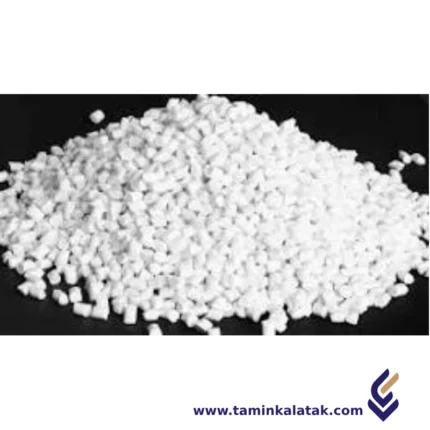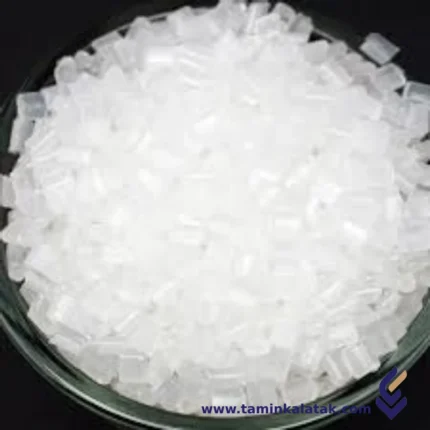Antiblock Masterbatch
Antiblock masterbatch is an additive used in plastic films and sheets to reduce surface adhesion and prevent blocking, where plastic layers stick together after processing. It contains fine inorganic particles such as silica, talc, or calcium carbonate, dispersed in a polymer carrier like PE (polyethylene) or PP (polypropylene).
Structure
The structure of antiblock masterbatch consists of a polymer carrier resin, typically polyethylene (PE) or polypropylene (PP), combined with finely dispersed inorganic antiblocking agents such as silica, talc, or calcium carbonate. These inorganic particles create a micro-rough surface on the plastic film, reducing contact area and minimizing adhesion between layers. The masterbatch is formulated to ensure uniform dispersion of the antiblocking agents, preventing film sticking while maintaining optical properties such as transparency and gloss. In addition to antiblocking agents, the formulation may include processing aids and slip additives to enhance film handling and extrusion performance. The overall composition is designed to provide effective antiblocking performance without compromising the mechanical and optical qualities of the final product.Properties
Antiblock masterbatch has several important properties that enhance the performance of plastic films and sheets. It effectively reduces blocking by introducing micro-roughness on the surface, preventing plastic layers from sticking together. The masterbatch is designed to maintain good optical properties, ensuring minimal impact on transparency and haze, which is especially important for clear films. It also improves the handling and processing of films by reducing friction, often working in combination with slip agents to enhance surface smoothness. The thermal and chemical stability of antiblock masterbatch ensures that it remains effective under high processing temperatures and various environmental conditions. Additionally, it enhances the efficiency of film unwinding, bag opening, and packaging applications without negatively affecting the mechanical strength of the polymer.Applications of Antiblock Masterbatch
- Blown Films – Used in LDPE, LLDPE, and HDPE films to prevent blocking.
- Cast Films – Applied in BOPP and CPP films for packaging and lamination.
- Agricultural Films – Helps prevent sticking in greenhouse and mulch films.
- Shrink and Stretch Wraps – Ensures smooth unwinding and handling.
- Thermoformed Sheets – Reduces adhesion in plastic trays and disposable containers.
- Flexible Packaging – Improves the usability of food and industrial packaging films.
Advantages of Antiblock Masterbatch
- Prevents Film Blocking – Reduces adhesion between plastic layers for easy handling.
- Maintains Transparency – Optimized formulations ensure minimal haze.
- Improves Processing Efficiency – Enhances film unwinding and bag separation.
- Compatible with Various Polymers – Works well with PE, PP, and other film resins.
- Enhances Surface Properties – Reduces friction when combined with slip agents.
- Cost-Effective – Reduces defects and improves production efficiency.
Disadvantages of Antiblock Masterbatch
- Potential Reduction in Clarity – High concentrations may slightly increase haze.
- Can Affect Surface Smoothness – Roughness introduced by antiblock agents may impact certain applications.
- Limited Performance in Thick Films – More effective in thin films than in rigid or thick sheets.
- Possible Interaction with Other Additives – Requires careful formulation to avoid negative effects on slip or anti-static properties.
Antistatic Masterbatch
Antistatic Masterbatch is a type of additive used in plastics to reduce or eliminate static electricity buildup. It is typically a concentrated blend of antistatic agents dispersed in a carrier resin, which can be easily incorporated into plastic materials during processing.
Structure
The structure of antistatic masterbatch consists of a polymer carrier resin combined with active antistatic agents. The carrier resin is chosen based on compatibility with the target plastic, such as polyethylene, polypropylene, or polystyrene, ensuring uniform dispersion during processing. The antistatic agents can be ionic or non-ionic compounds, often including ethoxylated amines, quaternary ammonium salts, or glycerol esters, which help in reducing surface resistivity. These agents migrate to the surface of the plastic over time, attracting moisture from the environment to dissipate static charges. Some formulations also include synergistic additives to enhance long-term performance or to provide immediate static dissipation. The concentration and type of antistatic agent determine the efficiency, duration, and application suitability of the masterbatch, making it a versatile solution for various industries such as packaging, electronics, and automotive components.Properties
Antistatic masterbatch possesses several key properties that make it effective in reducing static electricity in plastic materials. It has a controlled rate of migration, allowing the antistatic agents to move to the surface over time and attract moisture to dissipate static charges. The masterbatch is designed to be compatible with a wide range of polymers, ensuring uniform dispersion without affecting the mechanical properties of the final product. It provides both short-term and long-term antistatic effects, depending on the formulation, and can work in varying humidity conditions. Additionally, it does not significantly alter the transparency, color, or processability of the plastic. It is thermally stable, meaning it can withstand high processing temperatures without degradation. Some formulations are also food-grade compliant, making them suitable for applications in food packaging and medical devices. The electrical resistivity of the final product is reduced, preventing dust attraction, improving safety, and minimizing electrostatic discharge-related issues in sensitive environments like electronics and industrial manufacturing.Applications
- Used in plastic packaging such as films, bags, and containers to prevent dust accumulation.
- Applied in the automotive industry for interior plastic components to reduce static buildup.
- Used in electronics and electrical components to prevent electrostatic discharge (ESD) damage.
- Integrated into textile and fiber production to reduce static in synthetic materials.
- Utilized in industrial equipment like conveyor belts, storage bins, and plastic housings to prevent static-related handling issues.
- Found in medical and pharmaceutical packaging to maintain cleanliness and safety.
Advantages
- Effectively reduces static electricity, preventing dust attraction and improving product cleanliness.
- Enhances processing efficiency by reducing static-related handling issues during manufacturing.
- Improves safety by minimizing electrostatic discharge, which can be hazardous in electronics and industrial environments.
- Provides both short-term and long-term antistatic effects based on formulation.
- Compatible with various polymers, ensuring easy incorporation without significantly altering material properties.
- Can be formulated to be food-grade compliant, making it suitable for packaging and medical applications.
Disadvantages
- The effectiveness depends on humidity, as many antistatic agents require moisture to function.
- Some formulations have a limited lifespan, requiring reapplication or higher concentrations for long-term effects.
- May slightly affect optical properties, such as reducing transparency in clear plastics.
- In certain cases, migration of the antistatic agent to the surface can cause inconsistencies in performance over time.
- Can increase production costs, especially for high-performance or specialized formulations.








